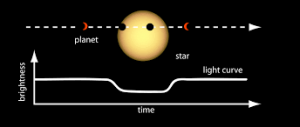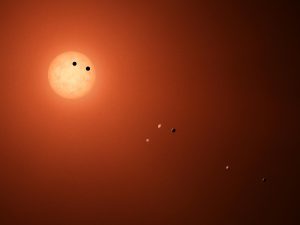Exoplanets: The TRAPPIST-1 System
Jessica B, Emery D, James M, Kirk M, Harsimran S, Jessica S
Introduction
The hunt for exoplanets is one of the fastest-growing enterprises in astronomy, and for very good reason. An exoplanet, or extra-solar planet, is any planet that orbits a star other than our own Sun. These planets vary in size and distance from their star. If we can find planets with similar composition and features to Earth, we may discover extraterrestrial life, or a potential future home for humanity. This page will explore one of the most bountiful results of the exoplanet search, TRAPPIST-1, anaylsing the composition of this planetary system and the methods used by astronomers to discover it, and how research of this planet will proceed in the future.
Background on TRAPPIST-1
While thousands of exoplanets have been discovered, only a fraction of these could have the ability to sustain life. The TRAPPIST system is a product of the exoplanet hunt that has yielded unusually high results. TRAPPIST-1 is an ultra-cool dwarf star 39.5 light-years away that is roughly the size of Jupiter and roughly 84 times as massive, and was first discovered using the TRAPPIST (the TRansiting Planets and Planestesimals Small Telescope). Additional planets were discovered using multiple other telescopes such as Spitzer Space Telescope and Liverpool Telescope.2 At 7 discovered exoplanets, TRAPPIST-1 has more detected planets than any other system. 5 of these planets are of similar size to Earth, with 3 of these orbiting in the habitable zone.3
Discovery of the TRAPPIST Exoplanets – The Transit Method

Light curve shows the decrease in brightness of the star as the planet passes between it and the observer6
The Transit Method allowed astronomers to discover the exoplanets that orbit TRAPPIST-1, as well as many others. It makes use of the simple idea idea that an exoplanet which crosses between its host star and Earth once an orbit will block a very small amount of light each time. Therefore, astronomers monitor the night sky in search of periodically dimming stars. An astronomer can tell that this object is truly a planet and not a foreign object in the galaxy by continually observing that star, making sure that this “dimming” happens once every orbital revolution and over the same length of time as the planet’s “year” goes by.7 Typically, a star will lose between 0.1% and 1% of its overall brightness depending on how large the planet passing over it is. The time the planet takes to pass between the observer and the star is dependent on the distance between the planet and the star.7 The repetition of the planet passing in-between the observer and the star helps astronomers observe the planet’s astrosphere. As the planet passes over the star, some of the starlight passes through the atmosphere of the planet, and scientists then analyze the colors of the light to learn more about the composition of the atmosphere.8 Free oxygen in the atmosphere is a potential indicator of life.7
The transit method comes with many advantages, but also quite a few disadvantages. Some advantages would include it being the most sensitive method for locating exoplanets, it can be used in conjunction with other methods to determine planetary density based on the mass and size of said exoplanet, as well as determining the atmospheric composition of the exoplanet. The disadvantages include the dependency of a transit to occur, the small window the scientist has to view said transit, the multiple transits needed to conclude that the object is in fact an exoplanet and the tendency to throw false positives. All of these add to a successful method in finding exoplanets, even though it relies heavily on luck and chance.9
All the planets in the TRAPPIST-1 system pass in front of their star, which enable astronomers to observe their transit from Earth. Scientists monitored repeated shadows that displayed during transit. This helped them resolve the composition of the planets, by tracking the rate of time the planets took to surpass the star, allowing them to measure the masses of the planets, therefore evaluating the densities and therefore their bulk composition – which is rocky. During transit scientists were also able to investigate the climate on these planets by looking at the light from the star that passed through the atmosphere of the planet.2
Features of the TRAPPIST-1 System
As mentioned above, the TRAPPIST-1 system is comprised of seven planets, all ranging from diameters 0.8 and 1.1 times the diameter of the Earth.10 Their periods are between 1.5 and 20 days, and they orbit relatively close to the star, only laying 1.6 million to 9.5 million kilometers from TRAPPIST-1.10 There are no Jupiter’s among this crowd, as these planets range from 0.4 to 1.4 Earth masses (Jupiter is 318 Earth masses).10,11
Astronomers have also been able to determine, based on the temperature of the star and the orbital radius of each planet, that these planets receive a similar amount of light as many planets in our own solar system. However, this does not necessarily mean they could be in the habitable zone for TRAPPIST-1, as the closest planet, TRAPPIST-1b, has an equilibrium temperature of about 400 Kelvin, which translates to about 127℃, well beyond the boiling point of water.2 At the other end of the spectrum, TRAPPIST-1h (the furthest planet) gets about as much light as Ceres, a dwarf planet in the asteroid belt, does from our sun, giving it a temperature of about -100℃.12 While these extreme cases may not be able to harbour life, it is reasonable to believe that some of the planets between them may have a better environment to host living organisms similar to our own.
The potential for life within the TRAPPIST-1 system can also be analysed through observing the atmospheric conditions of each planet. An atmosphere that remains present over very long periods of time is regarded as one of the most crucial criteria necessary for obtaining habitability on a planet. Using mathematical simulations of stellar winds along with the atmospheric ion escape rate for all TRAPPIST-1 planets, a study concluded that planets further away from the star hold atmospheres more suitable for life.16 Therefore, TRAPPIST-1h (the most outward planet) contains the atmosphere that will deteriorate at the slowest pace. According to predictions based off of the deterioration of Earth’s atmosphere, TRAPPIST-1h will support an atmosphere for approximately 109 years, while the most inward planets TRAPPIST-1b may only support an atmosphere for 108 years.16 This is problematic for the most inward planets because the origin of life on earth took over 5×108 years to evolve.16 It is not certain that all planets will evolve life on the same timetable, however it is our best approximation based on the knowledge attained thus far. The longer an atmosphere is supported, the chances also increase for more complex and even intelligible life forms to evolve.16 TRAPPIST-1h seems like the most capable of fostering life from an atmospheric standpoint, however it does not orbit within the habitat zone, making TRAPPIST-1g (the second furthest orbiting planet) the most likely to harbour life because of its increased chances of holding liquid water.
Future Research on the TRAPPIST-1 System – K2 and Spritzer
The TRAPPIST-1 system has given astronomers much to consider, but many questions still remain. K2 and JWST are two of the current missions that will work towards uncovering the secrets of TRAPPIST-1.
NASA’s Kepler Mission from 2009-2013 gave astronomers many things to consider while monitoring 150,00 stars including the orientation of the exoplanets planets in the galaxy. This mission came to an end due to the loss of the second of four reaction wheels.14 Months later the K2 mission was developed using the Kepler platform and put into action in 2014. The K2 missions operate on an ecliptic plane which minimizes solar wind pressure on the spacecraft, reducing the rotational torque, nullifying pointing drift.14 This allows the K2 missions to be controlled by thrusters and the remaining reaction wheels, allowing observation times of up to 80 days. K2 ultimately is a second chance for the damaged Kepler probe. In general, the Kepler Mission looks to study the stars that harbor planetary systems, as well as the dynamics of the planets that orbit them including orbit sizes, masses, densities and more.14
The James Webb Space Telescope, or simply JWST, is a future NASA, ESA and CSA collaboration set to launch in October of 2018.15 JWST is the ultimate multitasker, analysing not only the remnants of the cataclysmic Big Bang, but the formation of solar systems similar to our own, such as TRAPPIST-1.
In the future, scientists will be using K2 to get a more accurate reading if these planets truly have a rocky base, or if they are able to sustain water.4 The planets exhibit a harmoniously resonant orbital pattern and are tightly packed. This is somewhat of a mystery because previous models of planetary formation don’t explain how this highly compact system formed.5 Having seven planets so closely located will allow scientists to compare the atmospheric compositions and temperatures to one another using JWST in the distant future.4
Conclusion
The TRAPPIST-1 exoplanets are all connected in the dynamic and mysterious TRAPPIST-1 system. As you’ve seen above, astronomers have already learned so much about the composition and atmospheres of each planet and their relation to their star, but the search for answers is far from over. Future missions like K2 and JWST look to peel back the veil not only on the remaining unknowns of this planetary system, but on the thousands of other exoplanets that have been discovered just in our own small slice of the galaxy. They will also continue to search for a model that can accurately describe the formation of these diverse systems. Using the transit method and many other useful tools, astronomers are embarking on the largest exploration in the history of mankind, mapping out new worlds in the cosmos and learning new things about the cosmos every day.
Citations:
1 NASA/JPL-Caltech, TRAPPIST-1, https://en.wikipedia.org/wiki/TRAPPIST-1#/media/File:PIA21429_-_Transit_Illustration_of_TRAPPIST-1_(cropped).jpg (06/15/2017)
2 TRAPPIST-1 Official, About Trappist-1, http://www.trappist.one/#about, (06/08/2017)
3 Gillon et al, Temperate Earth-sized planets transiting a nearby ultracool dwarf star http://www.eso.org/public/archives/releases/sciencepapers/eso1615/eso1615a.pdf (06/08/2017)
4 TRAPPIST-1 Official, Future, http://www.trappist.one/#future, (06/08/2017)
5 Chris Ormel, Beibei Liu, Djoeke Schoonenberg, Formation of TRAPPIST-1 and other compact systems
https://arxiv.org/abs/1703.06924 (06/08/2017)
6 Light Curve of a Planet Transiting It’s Star:
https://www.nasa.gov/mission_pages/kepler/multimedia/images/transit-light-curve.html (06/15/2017)
7 Hans-Jorg Deeg. Transit Method, http://www.iac.es/proyecto/tep/transitmet.html (06/07/2017)
8 NASA. Searching for Shadows: Transit, https://exoplanets.nasa.gov/interactable/11/ (06/08/2017)
9 The Planetary Society. Transit Photometry: A Method for Finding Earths,
10 Astronomy Vol. 45 Issue 7, p. 8 (2017)
11 Universe Today, What are the Different Masses of the Planets?, https://www.universetoday.com/34024/mass-of-the-planets/ (06/21/2017)
12 Science News Vol. 191 Issue 12, p. 16 (2017)
13 NASA, Gallery, http://www.trappist.one/#posters (06/21/2017)
14 NASA. Kepler and K2, https://www.nasa.gov/mission_pages/kepler/overview/index.html (06/07/2017)
15 NASA, James Webb Space Telescope Overview, https://www.nasa.gov/mission_pages/webb/about/index.html (06/21/2017)
16 C. Dong, M. Jin, M. Lingam, V. S. Airapetian, Y. Ma, and B. van der Holst, Atmospheric escape from the TRAPPIST-1 planets and implications for habitability (2017).

